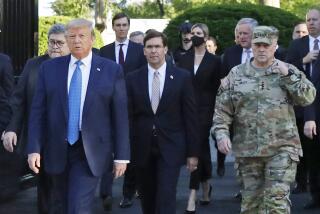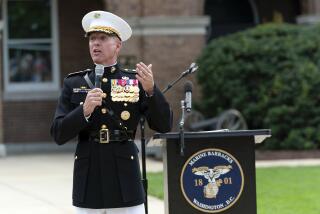Bush Asserts Himself as Commander in Chief : Authority: The U.S. command-and-control system was in disarray in Vietnam. This time, it is clear-cut and compatible.
The one phrase not heard during the present crisis in the Persian Gulf is “national command authority.” For the first time in many years, the military has a commander in chief and, as unlikely as it might have seemed only a year ago, it is George Herbert Walker Bush. From “the wimp in the White House,” he has turned into one of the strongest war Presidents since Franklin D. Roosevelt.
And that’s particularly good news.
In a recent interview in Vietnam magazine, former Secretary of the Navy James Webb noted that the United States had not won a war since the post of secretary of defense was created immediately after World War II. One could quarrel whether we won the Korean War, but Webb’s point was well taken. For many years our command-and-control system at the very top has been in disarray. As a result, we never had “unity of command” at the national level and, as a result, never had unity of effort.
Violation of this fundamental principle of war has had dire consequences, particularly in the Vietnam War. It was significant that during that war, the phrase “national command authority” came into vogue. This euphemism replaced “commander in chief” or “the President” in military plans and doctrines. It meant those--whoever they might be--who were making the final decisions on the operations, plans and strategies of the armed forces of the United States.
Despite his boast that the Air Force could not bomb so much as an outhouse without his permission, it was not President Lyndon B. Johnson but Harvard law school professor John McNaughton, then an assistant defense secretary, who ordered into execution the slow-squeeze strategy of gradualism that doomed U.S. military efforts in Vietnam. And Henry A. Kissinger bragged in his autobiography that it was he and Alexander M. Haig in the basement of the White House, and not President Richard M. Nixon, who were calling the shots during the closing months of that war.
More recently it was another basement interloper, Lt. Col. Oliver L. North, who was issuing orders in the name of the President during the Reagan Administration. For many years, when it came to national security issues, everyone and no one was in charge.
Part of the blame rested on the Presidents themselves who, for whatever reasons, abdicated their responsibility under the Constitution to serve as commander in chief of the armed forces. But, as Webb complained, part was also the fault of the convoluted organization for combat that had been created with the establishment of the Defense Department and the interposition of a political secretary of defense between the President and his uniformed military leaders.
Earlier, there had been a clear division of labor in the higher reaches of the military. As Karl von Clausewitz made clear in his writings, war has two complementary dimensions, preparation for war and the actual conduct of war. Both are essential for success, but each rests on entirely different philosophical foundations. Preparation for war--raising the force, training it, organizing, arming and equipping it--deals with fixed values and known quantities. Management and business skills are essential.
Conduct of war proper, on the other hand, deals with unknown quantities and the constant interaction of opposites. Here leadership, not management, is crucial and the skills of the warrior, not the businessman, are the ones that count.
Beginning with the Civil War, these two functions were divided between the civilian secretariat--the secretary of war (now the secretary of the Army) and the secretary of the Navy--and the uniformed heads of the Army and Navy. The civilians would handle the preparations for war; the military would handle the job of actually fighting the war.
As President Roosevelt made clear in a letter to his secretary of war in 1942 in the opening days of World War II, when it came to operations, strategies and tactics, he would exercise his authority as commander in chief directly through the Army chief of staff. Throughout the war, General of the Army George C. Marshall, the Army chief of staff, and Admiral of the Fleet Ernest King, the chief of naval operations, worked closely with the President to oversee the war. There was no doubt in anyone’s mind who was in charge.
And that continued throughout the Korean War as well. Although a secretary of defense had been interposed in the chain of command, during much of the war that post was held by Gen. Marshall. And when he left office because of ill health, his successor, Robert Lovett, deferred to Omar Bradley, the chairman of the Joint Chiefs of Staff and general of the Army, for the conduct of military operations.
But after that war, things came unglued.
Ironically, it was President Dwight D. Eisenhower who unwittingly set the national security system on the wrong track. Since as a former five-star general he did not need military advisers, he strengthened the office of the secretary of defense and focused its attention almost exclusively on preparation for war. Businessmen such as General Motors’ “Engine Charlie” Wilson and, later, Ford Motor Co.’s Robert S. McNamara, were named to manage that bureaucracy, and the skills of the warrior were dismissed as irrelevant.
As the New York Times’ Hanson Baldwin noted, during the crucial years of the war in Vietnam in 1965 and 1966, the Army chief of staff, Gen. Harold K. Johnson, saw President Johnson privately only twice. It was the managers, not the war fighters, who had the President’s ear. In his book “The Twenty-Five Year War,” Gen. Bruce Palmer, himself a member of the Joint Chiefs of Staff during that period, told how the military chiefs gave up in disgust and let the civilians manage the war to its ultimate disastrous conclusion.
In the aftermath of Vietnam, the nation’s organization for combat was revamped with the Goldwater-Nichols reorganization act. The chairman of the Joint Chiefs of Staff was put into the chain of command and the commanders in the field were given much greater authority. All this has paid off handsomely in the Gulf today. But running a war is much more than simply lines on an organizational chart.
A case can be made that the explanation for the fiasco in Vietnam did not lie with political science, or with military science. The answer was in astrology--we were star-crossed, with the wrong leaders in the wrong place at the wrong time. But this time the stars appear to be in their proper conjunction.
From Gen. H. Norman Schwarzkopf in the Gulf, to Gen. Colin L. Powell as chairman of the Joint Chiefs of Staff, to Defense Secretary Dick Cheney, to President Bush, the chain of command is not only clear-cut--it is compatible. The poison relationships of the Vietnam War are nowhere in evidence.
And this time there is no doubt in anyone’s mind who is in charge. When asked when the ground war might begin, Schwarzkopf did not prattle about “national command authority.” He said the decision would be made by the President. And Bush himself made clear that he and he alone would make that fateful decision, just as he made the decision to begin the air war more than a month ago. The United States once again has a commander in chief. That’s one more thing that Saddam Hussein did not count on.
More to Read
Get the L.A. Times Politics newsletter
Deeply reported insights into legislation, politics and policy from Sacramento, Washington and beyond. In your inbox three times per week.
You may occasionally receive promotional content from the Los Angeles Times.









